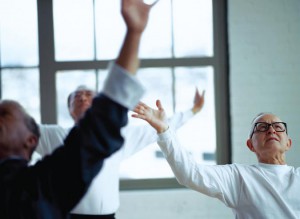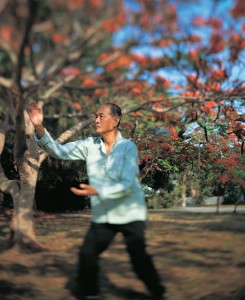By Jason Schneider
Exercise is important for people of all ages, but can be especially beneficial to people with memory problems, as well as their caregivers.
Low-impact exercises, such as water aerobics, yoga—and even simply walking—are often suggested for older adults. To improve balance and coordination, as well as combat joint stiffness and increase calmness and awareness, tai chi is an ideal choice.

An Ancient Practice
Tai chi, a mind-body practice that originated in China around the 12th century A.D. as a martial art, focuses on moving the body slowly and gently while breathing deeply and meditating. Studies have suggested that tai chi can help boost older adults’ immunity to viruses and improve their balance, thereby helping to prevent falls.
“The premise is to coordinate the movements with breathing, and many of them are simple movements or can be modified to fit the needs of older adults,” says Fabio Comana, MA, MS, ACE-CPT & LWMC, ACSM HFI, CSCS, CISSN, exercise physiologist and research scientist with the American Council on Exercise in San Diego, Calif. “It teaches the participant to evolve the movements, to flow freely, and integrate many of them.”
As a low-impact and aerobic exercise, tai chi can help improve physical condition, muscle strength, coordination, and flexibility; ease pain and stiffness; and improve sleep.
“[The various forms of tai chi] emphasize movement through three planes (breathing, relaxation, and meditation), and thus help maintain functional mobility at joints and integrate multiple joint movements, which helps older adults maintain their functional capacity,” says Comana. “In many of the movements, the eyes are closed, challenging the balance centers of the body. This certainly is key to functional capacity, given the risk of falls with older adults. It’s great training for balance and coordinated movements, parameters lost as we age.”
Movements in tai chi use the person’s own body as resistance and maintains a good range of motion at the joints, Comana adds. “Coupled with the slow movements, [tai chi] helps with many age-related conditions such as arthritis,” he says.
Staying Active
Because inactivity can lead to muscle weakness and other problems, it’s important for people with Alzheimer’s disease to continue physical activity as long as possible, says The Cleveland Clinic.

And although exercise doesn’t stop the disease from progressing, it gives patients a feeling of accomplishment. “In general, exercise improves cerebral blood flow, bringing more oxygen to the brain to help maintain neural and cognitive function,” says Comana. “Tai chi movements might be difficult to recall or perform with these [dementia] patients; basic, simple movements would have to be employed.”
The Mayo Clinic reports that up to 70 percent of people with Alzheimer’s also have symptoms of depression. They may eventually withdraw from all activities because, over time, they lose the ability to take part in the activities they once enjoyed. Exercise, such as tai chi, might help reduce depression in patients able to do the exercise and may alleviate boredom or loneliness.
Precautions
As with any exercise, there are some precautions to take into consideration before practicing tai chi. Although relatively safe, like any exercise, it should be done with care. The National Center for Complementary and Alternative Medicine, part of the National Institutes of Health, offers these tips:
- Tell your health care provider if you are considering learning tai chi for health purposes, especially if you have a health condition for which you are being treated, if you have not exercised in a while, or if you are an older person.
- If you do not position your body properly in tai chi or if you overdo practice, you may get sore muscles or sprains.
- Tai chi instructors often recommend that people not practice tai chi right after they eat, when they are very tired, or when they have an active infection.
- Use caution if you have any of the conditions listed below, as your health care provider should advise you whether to modify or avoid certain postures in tai chi:
- Pregnancy
- Hernia
- Joint problems, back pain, sprains, a fracture, or severe osteoporosis
- A complementary/alternative medicine approach should not be used to replace conventional medical care or to delay seeking that care.
Getting Started
As the caregiver of a person with Alzheimer’s, you may want to explore your community’s resources to find exercise programs or classes. You may even want to start a class yourself for other caregivers and Alzheimer’s patients. There are many resources available online.
By exercising with the person whom you are caring for, not only are you both benefiting from participating in pleasant activity, says the Mayo Clinic, you are helping to control many of the health problems found in older adults, such as diabetes, high blood pressure, and high cholesterol.
No matter what form of exercise you choose to do, you can help improve your loved one’s quality of live—as well as your own.
Online Resources
Listed below are a few resources for finding additional information about exercise and Alzheimer’s disease.
- American Council on Exercise
- The Cleveland Clinic
- The Mayo Clinic
- MedlinePlus (type “Alzheimer’s exercise” in the search bar)
- National Center for Complementary and Alternative Medicine
Source: www.ALZinfo.org. Author: Jason Schneider, Preserving Your Memory: The Magazine of Health and Hope; Spring 2008.










